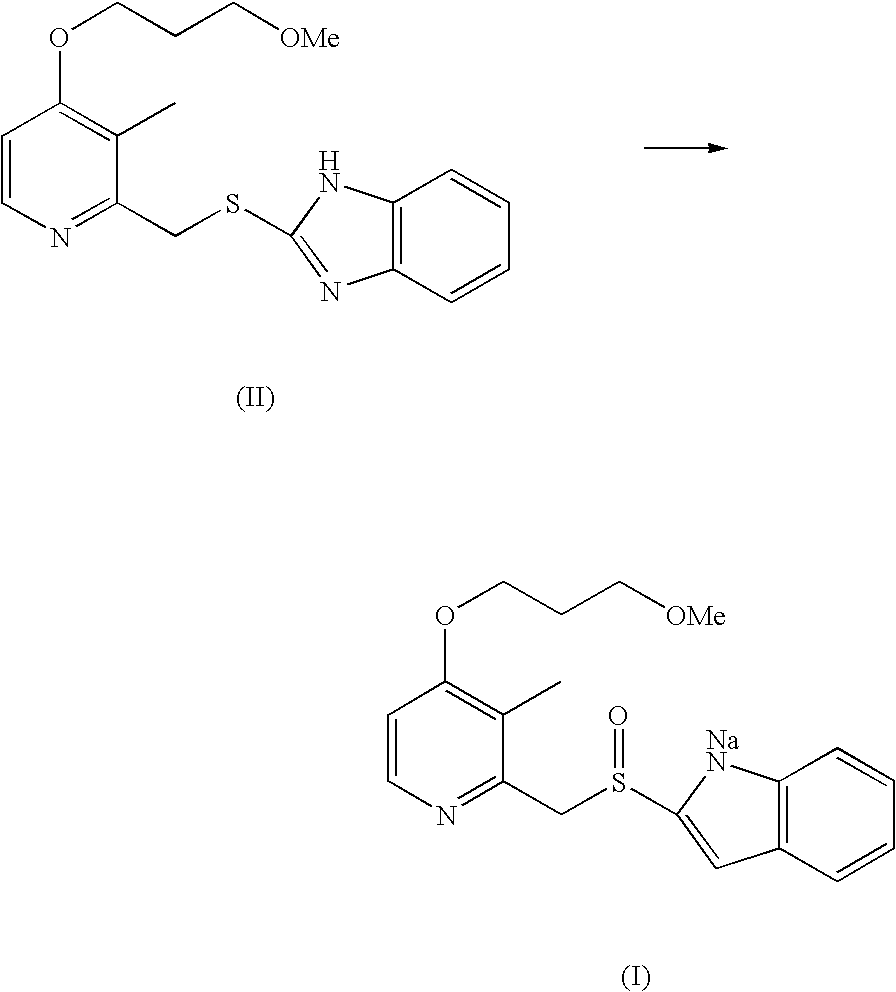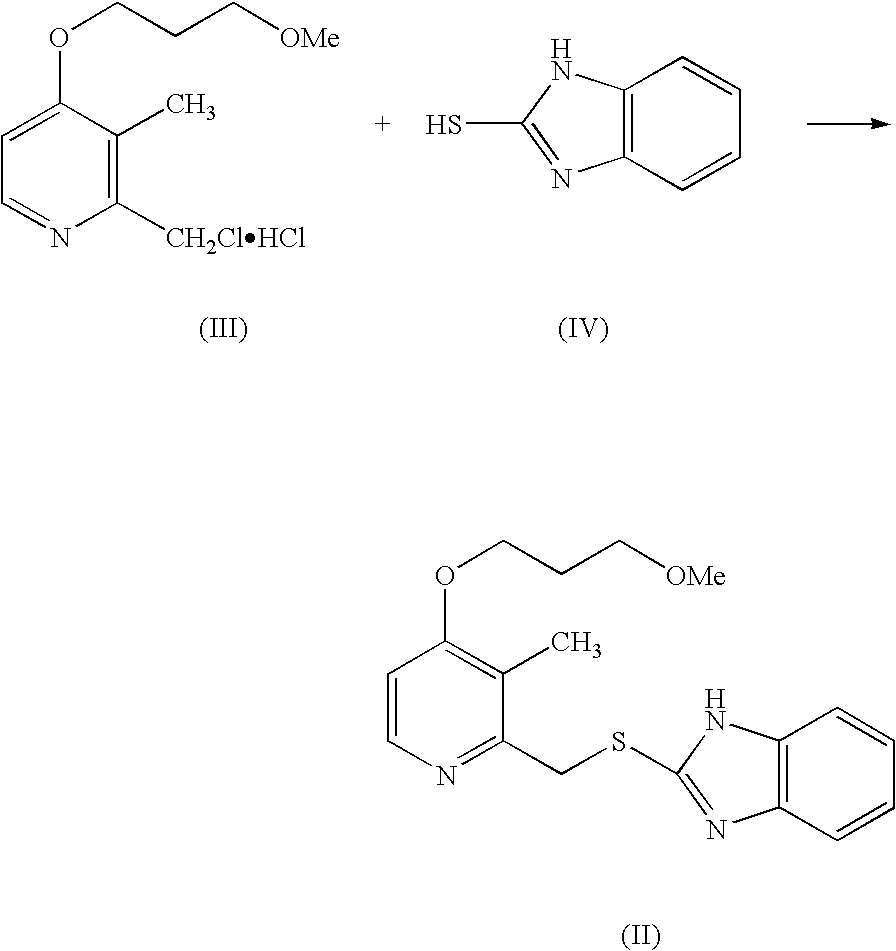Process for Synthesis of Proton Pump Inhibitors
a proton pump inhibitor and proton pump technology, applied in the field of proton pump inhibitor synthesis, can solve the problems of low potency, method is not suitable for industrial scale preparation of rabeprazole sodium, and prior art processes that are cited above have many disadvantages and are not ideally suited for industrial application
- Summary
- Abstract
- Description
- Claims
- Application Information
AI Technical Summary
Benefits of technology
Problems solved by technology
Method used
Image
Examples
example 1
Preparation of 2-[[[4-(3-methoxy propoxy)-3-methyl-2-pyridinyl]methyl]-thio]-1H-benzimidazole (Rabeprazole Sulphide)
[0028]2-Mercapto benzimidazole (15 g) was suspended in 500 ml Purified water and Sodium hydroxide (8 g). To this was slowly added about 25 g of 2-Chloromethyl-3-methyl-4-(methoxy propoxy)pyridine hydrochloride. The reaction mass was stirred for 2 hours at 20-30° C. and solids were filtered and the wet material can be directly taken up for oxidation or optionally dried in an oven at 45-50° C. to give 31 gm of the title compound.
example 2
Preparation of 2-[[[4-(3-methoxy propoxy)-3-methyl-2-pyridinyl]methyl]-sulfinyl]-1H-benzimidazole sodium (Rabeprazole Sodium)
[0029]2-Mercapto benzimidazole (15 g) was suspended in 500 ml Purified water and Sodium hydroxide (8 g). To this was slowly added about 25 g of 2-Chloromethyl-3-methyl-4-(methoxy propoxy)pyridine hydrochloride. The reaction mass was stirred for 2 hours at 20-30° C. and solids were filtered to obtain 2-[[[4-(3-methoxy-propoxy)-3-methyl-2-pyridinyl]methyl]-thio]-1H-benzimidazole.
[0030]The above wet material was suspended in 700 ml Purified Water, Sodium hydroxide (8 g) and Pyridine (17.0 ml). To this 215 g of sodium hypochlorite solution having a chlorine content of 3.2% was slowly added at 5-10° C. in 2 hours. The reaction mass was maintained at 5-8° C. for 2-4 hours. After completion of the reaction, excess sodium hypochlorite was decomposed using 5% aqueous sodium thiosulphate solution. The reaction mass was saturated with about 210 gm of sodium chloride and ...
example 3
Preparation of 2-[[[4-(3-methoxy propoxy)-3-methyl-2-pyridinyl]methyl]-sulfinyl]-1H-benzimidazole sodium (Rabeprazole Sodium)
[0032]2-[[[4-(3-methoxy-propoxy)-3-methyl-2-pyridinyl]methyl]-thio]-1H benzimidazole (25 g) was suspended in 500 ml of Purified Water, Sodium hydroxide (5 g) and Pyridine (12.5 ml). To this was slowly added about 160 g of Sodium hypochlorite solution having a chlorine content of 3.2% at 5-10° C. in 2 hours. The reaction mass was maintained at 5-8° C. for 2 hours. After completion of the reaction, excess Sodium hypochlorite was decomposed using 5% aqueous Sodium thiosulphate solution. The reaction mass was then saturated with 150 g of Sodium chloride and extracted with 250 ml of dichloromethane twice. The organic layer was then dried over anhydrous Sodium sulphate. Concentrating the organic layer under vacuum yielded a residue to which 125 ml of Ethyl acetate was added and heated to 45-50° C. for dissolution. This solution was slowly added to 500 ml of n-Heptan...
PUM
| Property | Measurement | Unit |
|---|---|---|
| temperature | aaaaa | aaaaa |
| temperature | aaaaa | aaaaa |
| temperature | aaaaa | aaaaa |
Abstract
Description
Claims
Application Information
 Login to View More
Login to View More - R&D
- Intellectual Property
- Life Sciences
- Materials
- Tech Scout
- Unparalleled Data Quality
- Higher Quality Content
- 60% Fewer Hallucinations
Browse by: Latest US Patents, China's latest patents, Technical Efficacy Thesaurus, Application Domain, Technology Topic, Popular Technical Reports.
© 2025 PatSnap. All rights reserved.Legal|Privacy policy|Modern Slavery Act Transparency Statement|Sitemap|About US| Contact US: help@patsnap.com


